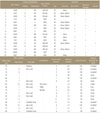Abstract
Purpose
Although nonunion is a relatively common complication in the management of subtrochanteric fractures, there are few studies regarding the treatment of nonunion. The purpose of this study was to evaluate clinical and radiological results for the treatment of subtrochanteric nonunions with a blade plate.
Materials and Methods
We retrospectively analyzed 16 cases of subtrochanteric nonunions that were treated with a blade plate between April 1997 and June 2008 and were followed for at least one year after the index operation. There were 8 males and 8 females with an average age of 58 years (range, 42-77 years). Outcome variables included the time to union, postoperative complications, Harris hip score, and the functional rating scale of Sanders. The average follow-up period was 26 months (range, 12-63 months).
Results
Union was achieved in 15 (94%) of 16 subtrochanteric nonunions after an average of 7 months (range, 4-11 months). One patient who did not reach union after the index operation underwent repeated surgery with a longer blade plate and bone graft, but this patient was eventually treated with total hip arthroplasty because of persistent nonunion and breakage of the blade plate. Two patients developed complications. One patient had bursitis around the greater trochanter and the other developed avascular necrosis of the femoral head. Of these, the patient with avascular necrosis of the femoral head was treated with total hip arthroplasty because of persistent hip pain 2 years after the index operation. At latest follow-up, the mean Harris hip score was 88 points (range, 36-100 points) and the functional rating scale of Sanders was good or excellent in 14 (88%) of 16 patients.
Figures and Tables
 | Figure 1(A) Anteroposterior and lateral radiographs of the hip of a 42-year-old man show an atrophic nonunion of subtrochanteric fracture previously treated with a cephalomedullary nail. (B) Correction of varus and flexion malalignment, fixation with a blade plate, and autogenous cancellous bone grafting were performed. (C) Radiograph taken 12 months after the index operation show union in good alignment. (D) Postoperative radiograph after hardware removal. |
 | Figure 2(A) Anteroposterior and lateral radiographs of the hip of a 77-year-old women show a hypertrophic nonunion of subtrochanteric fracture with metallic failure of a dynamic hip screw implant. (B) Broken hardware was removed and a blade plate was applied without bone grafting. (C) Radiograph taken 6 months after the index operation show union in a slightly valgus position. (D) Radiographs taken 53 months after the index operation are shown. |
References
1. Siebenrock KA, Müller U, Ganz R. Indirect reduction with a condylar blade plate for osteosynthesis of subtrochanteric femoral fractures. Injury. 1998. 29:Suppl 3. C7–C15.

2. Kim HT, Cho YH, Byun YS, Kim JH, Bang HH, Nam SO. Treatment of subtrochanteric fractures of the femur with a condylar blade plate. J Korean Hip Soc. 2005. 17:65–69.
3. Hwang CS, Chung PH, Kang S, et al. Treatment of subtrochanteric femur fractures using intramedullary devices. J Korean Fract Soc. 2008. 21:13–18.

4. Barquet A, Mayora G, Fregeiro J, López L, Rienzi D, Francescoli L. The treatment of subtrochanteric nonunions with the long gamma nail: twenty-six patients with a minimum 2-year follow-up. J Orthop Trauma. 2004. 18:346–353.
5. Haidukewych GJ, Berry DJ. Nonunion of fractures of the subtrochanteric region of the femur. Clin Orthop Relat Res. 2004. (419):185–188.

6. de Vries JS, Kloen P, Borens O, Marti RK, Helfet DL. Treatment of subtrochanteric nonunions. Injury. 2006. 37:203–211.

7. Wu CC. Locked nailing for shortened subtrochanteric nonunions: a one-stage treatment. Clin Orthop Relat Res. 2009. 467:254–259.

8. Park J, Kim SG, Yoon HK, Yang KH. The treatment of nonisthmal femoral shaft nonunions with im nail exchange versus augmentation plating. J Orthop Trauma. 2010. 24:89–94.

9. Kinast C, Bolhofner BR, Mast JW, Ganz R. Subtrochanteric fractures of the femur. Results of treatment with the 95 degrees condylar blade-plate. Clin Orthop Relat Res. 1989. 238:122–130.
12. Weber B, Cech O. Classification of disturbed fracture healing. 1973. Verlag Hans Huber.
13. Harris WH. Traumatic arthritis of the hip after dislocation and acetabular fractures: treatment by mold arthroplasty. An end-result study using a new method of result evaluation. J Bone Joint Surg Am. 1969. 51:737–755.




 PDF
PDF ePub
ePub Citation
Citation Print
Print



 XML Download
XML Download